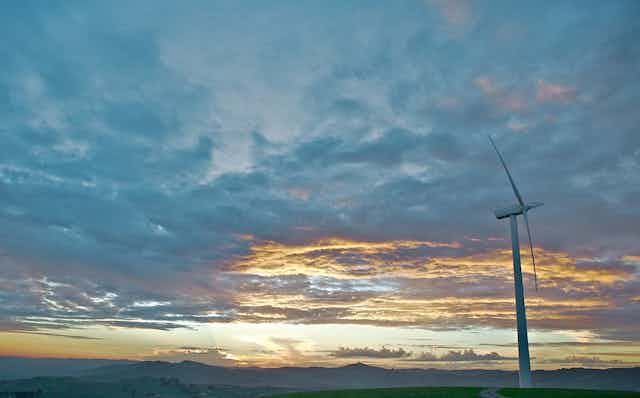Earlier this month, Victorians woke to the news that they had a new premier: Dennis Napthine, member for the South-West Coast District, would take over from Ted Baillieu to lead the state. As climate change and energy law researchers, the first question on our lips was, will Premier Napthine repeal the highly restrictive wind farm planning rules introduced under Baillieu in 2011?
Napthine has since said he would not revisit these changes. But wind power has brought great benefits to communities in Napthine’s own electorate: shouldn’t he extend those benefits to the rest of the state?
Baillieu’s restrictive wind farm planning laws
As we have written in this forum before, Victoria’s Baillieu government introduced some of the strictest wind farm planning regulations in Australia.
The Planning and Environment Act 1987 requires that planning in Victoria promote the principles of ecologically sustainable development. This involves “balance[ing] the present and future interests of all Victorians” (section 4(1)(g). We have already discussed how the current wind farm planning regime falls short of a true balancing of global and local interests.
In a nutshell, the 2011 amendments to the Victorian Planning Provisions restrict wind farm developments in Victoria by introducing:
no-go zones in areas including the Yarra Valley and Dandenong Ranges, Mt Macdedon and Mc Harg Ranges, as well as Bellarine and Mornington Peninsulas, and all land within 5km of high water mark on the Great Ocean Road and the Bass Coast
a 5km ban around major regional centres
the need to obtain the written consent of any owner of a dwelling within 2km of any turbine
a requirement for decision-makers to consider the need to minimise the effects of wind farms on the local community.
As the explanatory report notes, these changes “support greater consideration of local amenity impacts.”
Laws introduced to give local communities a greater voice
The justification for these changes, according to the Coalition’s 2010 election policy is to “restore fairness and certainty to the planning process for wind farms” by giving local communities a “key role in deciding where wind farms will go”.
Given the restrictiveness of the wind planning provisions, the assumption seems to be that local communities, especially in the no-zones, are generally opposed to wind farms. The emphasis on “landscape values” and amenity over other interests, including economic development and clean energy solutions, narrows the scope of communities’ interest.
Communities have diverse values and interests, often supportive of wind energy. For example, the BEAM Mitchell group supports a new local wind farm, but has found its voice drowned out by anti-wind interests in a case that is currently before the Victorian Civil and Administrative Tribunal.
All community concerns and interests should be heard and considered in the planning process, instead of being preempted by no-go zones. The Woodend Integrated Sustainable Energy Group is a case in point. The group’s plans for a community wind farm in Macedon Ranges were dashed by the planning law changes.
In its study on rural wind farms in Australia, the CSIRO emphasises not only the environmental but also economic benefits of wind farms. In SA, the current wind energy power house of Australia, for example, wind energy has led to the investment of billions of dollars and considerable job creation at a community level.
Napthine’s “renewable energy hub”
Napthine’s electorate in the south west corner of Victoria is home to some of Victoria’s biggest wind farms. Indeed Napthine’s electoral website proudly describes the region as a “renewable energy hub, with a number of wind farms already in the electorate, with further planned”.
Apart from cutting dangerous carbon emissions, the local benefits of a burgeoning wind energy sector have been a major reason for Napthine’s support of wind farms in his electorate. In 2006 the Bracks government approved what was to be Australia’s largest wind farm project, the Macarthur wind farm. At the time Napthine, as the local member, told ABC radio:
I certainly do welcome this approval. The Macarthur wind farm projects has been on the books for a number of years now and it has broad community support. It will provide jobs. It is a good location for a wind farm and I support it.
In addition to jobs in construction, Napthine’s electorate has benefited from wind turbine manufacturing. Keppel Prince, a wind farm component manufacturer, is a major employer in the region. As recently as late February 2013, Napthine was publicly calling for greater support for the manufacturer.
The jobs of Keppel Prince’s employees are at risk due to a downturn in the sector, which the manufacturer feared would be the result of the 2011 planning law changes.
Indeed, all the wind farms in operation or under construction in Napthine’s electorate were approved prior to the 2011 planning law changes. With the new “no go” zones around regional centres, some of the wind farms near Portland may have never been built.
As we emerge from a record hot summer (and start to autumn!) in part due to climate change, the case for moving Victoria’s power sector away from highly polluting brown coal to clean energy has never been greater. Balancing the interests of all Victorians – including those of future generations – means it is time to reconsider the wind farm planning framework.
The current stranglehold threatens the opportunity for communities to reap the benefits of jobs and manufacturing, a cleaner power sector and a safer climate.

